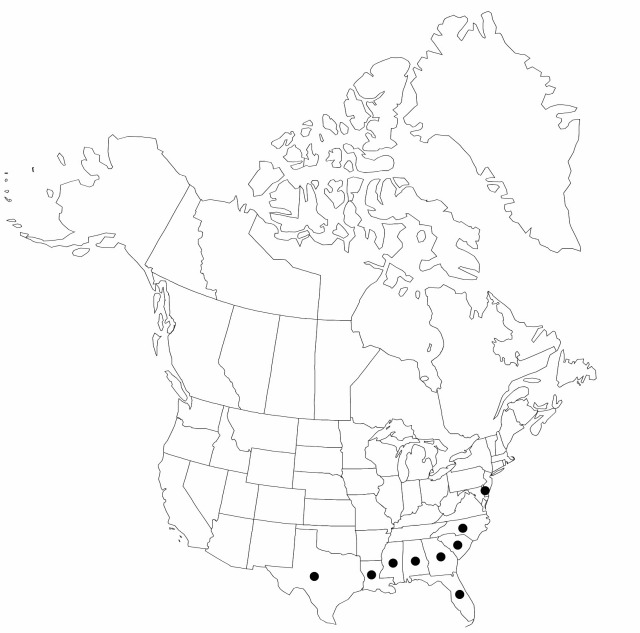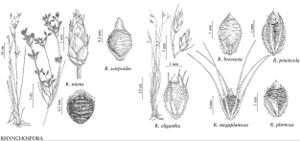Rhynchospora plumosa
Sketch Bot. S. Carolina 1: 58. 1816.
Plants perennial, mostly densely cespitose, (10–)20–80 cm, bases pale brown to dull deep brown; rhizomes absent. Culms erect or excurved, filiform to linear. Leaves erect or excurved, shorter than scape; blades filiform to linear, to 1.5 mm wide, margins involute, apex trigonous, tapering. Inflorescences: spikelet clusters 1–several, dense or sparse, when several, either widely spaced or close together, if widely spaced then ovoid to hemispheric, if close together then lobed ellipse or cylinder; leafy bracts filiform, setaceous, overtopping each cluster. Spikelets light redbrown to deep brown, broadly fusiform to ovoid, (2.5–)3.5–4 mm, apex acute to acuminate; fertile scale broadly ovate, strongly convex, (1.5–)2–3 mm, apex acuminate to mucronate, midrib excurrent or not. Flowers: perianth bristles 6, plumose, reaching at least to fruit midbody, often to tubercle tip. Fruits 1(–2) per spikelet, (1.5–)2–2.5 mm; body redbrown or brown, tumidly obovoid or ellipsoid, sometimes obscurely lenticular, (1.2–)1.3–1.8(–2) × 1–1.5 mm; surfaces interruptedly crossrugulose; tubercle narrowly to broadly conic, mostly 0.3–0.5 mm, base flaring, round or indistinctly 2lobed.
Phenology: Fruiting spring–fall or all year (south).
Habitat: Sands and peats of pine flatwoods, sandhills ecotones, savannas, upper pond shores, often in the wiregrass zone
Elevation: 0–300 m
Distribution

Ala., Del., Fla., Ga., La., Miss., N.C., S.C., Tex., West Indies, Central America.
Discussion
Particularly in Gulf Coastal Plain savannas, Rhynchospora plumosa appears to have two distinct morphs: one very densely cespitose with filiform leaves, filiform, arching culms, and spikelets in short, broad, dark brown clusters, and the other morph taller, stiffer, with broader leaves and culms, and longer, sharper, paler spikelets in narrow compounds of clusters. After many attempts to do what others have—namely to create two distinct species—I have had to retrench, because so many intergrades occur.
Selected References
None.
